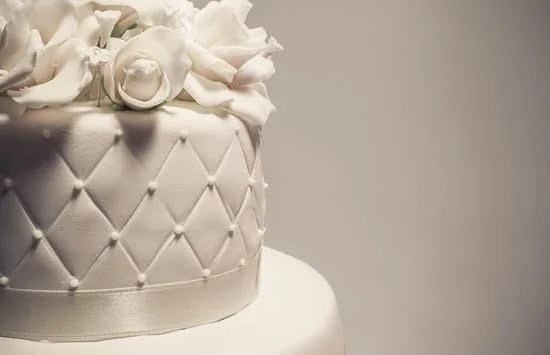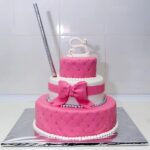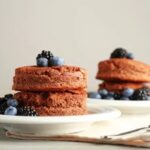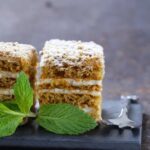When it comes to cake decorating, the foundation is everything. A dense cake provides the perfect canvas for elaborate and intricate designs, allowing your creativity to shine through. In this article, we will explore why a dense cake is ideal for decorating purposes and delve into the science behind achieving that desired texture. We will also highlight popular types of dense cakes commonly used in decorating and provide tips and tricks for baking the perfect dense cake at home.
A dense cake serves as a sturdy base for any decoration you have in mind. Whether you’re planning to create intricate piping designs, sculpted shapes, or cover the entire cake with fondant, a denser texture ensures that your creation remains intact throughout the process. Unlike lighter cakes that may crumble under the weight of decorations or collapse when handled, a dense cake holds its shape and structure with confidence.
The secret to achieving a dense texture lies in understanding the science behind it. In the following section, we will explore how different ingredients and techniques contribute to creating a denser cake.
From carefully selecting ingredients with higher fat content to omitting leavening agents that would add airiness, each step plays a significant role in achieving that desired density. By understanding these factors, you can experiment with various recipes and techniques to tailor your cakes perfectly for any decoration style you envision.
Stay tuned as we uncover the artistry of decorating on a dense cake by exploring different frosting options and showcasing stunning examples of intricately decorated cakes. We’ll also provide practical guidance on storing and transporting your creations while maintaining their beauty.
So whether you’re an experienced baker looking to expand your skills or someone just starting out in the world of cake decorating, this article aims to inspire you and give you all the tools necessary to unleash your creative genius on a perfectly dense cake.
The Science Behind a Dense Cake
A dense cake may seem counterintuitive when it comes to achieving a light and fluffy texture, but there is actually a scientific explanation behind why a dense cake is perfect for decorating. Understanding the science behind a dense cake can help bakers have more control over their creations and create cakes that not only look stunning but also taste delicious.
The Ingredients and Techniques Behind Density
Creating a dense cake involves careful consideration of the ingredients and techniques used in the baking process. One key factor is the ratio of ingredients, especially fats and flours. A higher fat content contributes to density as it weighs down the structure of the cake, resulting in a more solid texture. Similarly, using denser flours such as all-purpose flour instead of cake flour can contribute to density.
Another important aspect is mixing techniques. Overmixing the batter can develop gluten, which provides structure but can also lead to a dense texture. Alternately, gently folding in dry ingredients with wet ones can help maintain a denser texture while avoiding excessive gluten development.
Omitting Leavening Agents for Density
One method commonly used to achieve density in cakes is omitting leavening agents such as baking powder or baking soda. These agents create air bubbles, causing the cake to rise and become lighter in texture. By eliminating them, bakers have better control over the density of the cake and can ensure a sturdier base for elaborate decorations.
When designing an intricately decorated cake, having a sturdy base allows for better support and stability throughout the decorating process. It prevents decorations from sinking or collapsing and helps maintain the desired design until it is ready to be enjoyed.
Understanding these scientific principles empowers bakers to experiment with different recipes and techniques to achieve just the right level of density for their decorating needs. With this knowledge, they can confidently embark on their creative baking endeavors knowing that they are building their designs on a solid foundation.
Popular Types of Dense Cakes for Decorating
When it comes to decorating cakes, choosing the right type of cake is crucial. A dense cake provides the perfect base for elaborate decorations, as its sturdy texture can withstand the weight of various decorations without collapsing. Here are some popular types of dense cakes that are commonly used for decorating:
- Pound Cake: Pound cake is a classic choice for decorators due to its dense and moist texture. It gets its name from the traditional recipe which consists of a pound each of flour, sugar, butter, and eggs. The high-fat content in pound cake contributes to its density, making it ideal for supporting intricate designs and fondant work.
- Chocolate Fudge Cake: If you’re looking to create a rich and indulgent cake that can hold up well under heavy decorations, chocolate fudge cake is an excellent choice. This dense cake is made with ingredients like cocoa powder or melted chocolate, giving it an intense chocolate flavor and a moist, fudgy texture. Its robust structure makes it perfect for stacking layers or carving intricate shapes.
- Carrot Cake: Carrot cake may not be the first type that comes to mind when thinking about dense cakes, but its unique texture makes it a fantastic option for decorating. Made with grated carrots and usually containing ingredients like nuts and raisins, carrot cake has a denser crumb while still being incredibly moist. Its sturdiness allows for elaborate piping designs or even constructing multi-tiered cakes.
These are just a few examples of dense cakes that lend themselves well to decoration. Each type offers its own distinct characteristics and suitability for specific decoration styles or techniques.
If you’re considering baking a dense cake for your next decoration project, here are some tips and tricks to ensure perfection.
Tips and Tricks for Baking a Perfect Dense Cake
Baking a perfect dense cake requires careful attention to detail and the right techniques. Here are some tips and tricks to help you achieve a dense texture in your cake:
Ingredient Selection
- Use ingredients at room temperature, as this helps create a smoother batter.
- Opt for cake flour instead of all-purpose flour. Cake flour has a lower protein content, resulting in a finer texture.
- Choose high-fat ingredients such as butter or full-fat dairy products. The higher fat content adds moisture and richness to the cake.
- Consider using sour cream, yogurt, or buttermilk to provide additional moisture and produce a denser crumb.
Mixing Techniques
- Cream the butter and sugar together until light and fluffy. This process incorporates air into the batter, which contributes to a lighter texture.
- When adding dry ingredients, use the folding method rather than vigorously stirring or beating the mixture. Overmixing can lead to a tougher texture.
- Be mindful not to overbeat the batter once the dry ingredients are added since this can develop too much gluten, resulting in a less dense cake.
Baking Time and Temperature
- Bake at lower temperatures (around 325°F/163°C) for longer periods rather than high temperatures for shorter times. This slower baking ensures that the cake cooks evenly without excessive rise.
- Use an oven thermometer to ensure accurate temperature control, as ovens can vary in calibration.
- Avoid opening the oven door frequently while baking since it can cause fluctuations in temperature and result in an uneven bake.
Remember that achieving the perfect density may take some practice, so don’t get discouraged if your first attempt doesn’t turn out exactly as planned. By following these tips and tricks, you’ll be well on your way to baking a deliciously dense cake that’s ideal for decorating.
The Versatility of Decorating on a Dense Cake
Decorating a cake is an art form that allows individuals to express their creativity and showcase their skills. When it comes to decorating, a dense cake offers a high level of versatility and is the perfect canvas for elaborate designs. The density of the cake provides a sturdy base, allowing for intricate piping, sculpting, and fondant work.
One of the advantages of decorating on a dense cake is the ability to achieve precise details with piping. The firm texture of the cake allows for cleaner lines and more intricate designs. Whether it’s creating delicate flowers or writing personalized messages, the density of the cake ensures that these decorations will hold their shape and not melt or collapse.
Sculpting is another technique that flourishes on a dense cake. The sturdiness and stability of the cake make it easier to carve and shape into various forms. From three-dimensional figures to tiered structures, decorating on a dense cake opens up endless possibilities for creating visually stunning masterpieces.
Fondant work is also enhanced by using a dense cake as the base. Fondant icing can be rolled out smoothly onto the surface without fear of sinking into gaps or cracks that may appear in lighter cakes. This results in a flawless finish that serves as an excellent foundation for adding additional decorations such as hand-painted designs or elegant sugar flowers.
The versatility of decorating on a dense cake goes beyond just techniques; it also extends to different decoration styles. Whether you prefer classic elegance, whimsical designs, or modern minimalism, dense cakes can adapt to any aesthetic. Their solid structure allows for seamless blending of colors, textures, and different mediums such as edible paints or metallic accents.
Frosting and Icing Options for Dense Cakes
When it comes to decorating a dense cake, choosing the right frosting and icing is crucial. The texture and flavor of these elements can enhance the overall design and complement the denseness of the cake. There are various options available that can be tailored to suit personal preferences and specific cake designs.
One popular choice for dense cakes is buttercream frosting. Buttercream is a versatile option that can be easily flavored and colored to match any design theme. Its smooth texture makes it ideal for piping intricate decorations, while its creamy consistency adds richness to the cake. Swiss meringue buttercream is another option that offers a lighter texture without compromising on stability, making it perfect for delicate designs.
Ganache is another excellent choice for decorating dense cakes. Made from a combination of chocolate and cream, ganache provides a glossy finish and rich flavor. It can be poured over the cake for a sleek look or whipped into a light frosting consistency for piping decorations.
In addition to buttercream and ganache, cream cheese frosting also pairs well with dense cakes, especially those with a tangy or spiced flavor profile such as carrot cake. Cream cheese frosting adds a touch of sweetness while providing a slight tangy contrast that balances out the denseness of the cake.
| Frosting/Icing | Best Suited Cake Flavors |
|---|---|
| Buttercream | Vanilla, Chocolate, Red Velvet |
| Swiss Meringue Buttercream | Citrus flavors like lemon or orange, Coffee |
| Ganache | Chocolate, Raspberry, Salted Caramel |
| Cream Cheese Frosting | Carrot, Spice, Pumpkin |
Inspiration
A Feast for the Eyes
Decorating a cake is more than just slathering on some frosting and sprinkles. It’s an art form that allows bakers to express their creativity and create stunning edible masterpieces. When it comes to working with dense cakes, the possibilities are endless. The sturdy base of a dense cake allows for intricate details, precise piping, and elaborate decorations that can truly take your breath away.
Piping Perfection
One of the most popular techniques used to decorate dense cakes is piping. Piping involves using a pastry bag and different types of nozzles to create intricate designs on the cake’s surface. With a dense cake, you have the advantage of stability and durability, making it much easier to pipe delicate patterns such as lacework, flowers, or even personalized messages. The denseness of the cake holds these piped designs firmly in place without compromising their shape or definition.
Fondant Fantasies
Fondant is another popular choice for creating impressive decorations on a dense cake. Fondant is a pliable icing that can be rolled out into thin sheets and draped over the cake to create a smooth sculpted appearance.
The density of the cake provides an ideal foundation for fondant work as it prevents sagging or collapsing under the weight of the fondant. From elegant wedding cakes adorned with cascading fondant ribbons to whimsical birthday cakes featuring fondant characters, there is no limit to what you can achieve when decorating with fondant on a dense cake.
When it comes to decorating cakes, using a dense cake offers countless opportunities for artistic expression. With sturdy construction and limitless options for creative decorations, it’s no wonder that dense cakes continue to be favored by both amateur bakers and professional pastry chefs alike.
So whether you’re planning to whip up an elaborate multi-tiered masterpiece or simply want to try your hand at some intricate piping, grab a dense cake as your canvas and let your imagination run wild.
Practical Guide
Storing and transporting a decorated dense cake requires special care to ensure that all the hard work put into decorating it doesn’t go to waste. Here are some practical tips and guidelines to follow to keep your cake fresh and intact:
Firstly, it is important to properly cool the cake before storing or transporting it. Allow the cake to cool completely on a wire rack before applying any frosting or decorations. This ensures that the frosting won’t melt or smudge during storage.
Once the cake is cooled and decorated, it should be stored in a cool, dry place. Avoid placing it in direct sunlight or near any sources of heat as this can cause the decorations to melt or warp. A temperature-controlled environment is ideal for keeping the cake fresh.
To protect the decorations on top of the cake, consider covering it with a food-safe plastic dome or tent-like structure. This provides an additional layer of protection against dust, insects, and accidental damage during transportation.
When it comes to transporting the decorated dense cake, take extra precautions to keep it stable and secure. Place the cake on a sturdy cake board or base that is larger than the bottom layer of the cake itself. This provides stability and makes it easier to transport without damaging the delicate decorations.
If possible, refrigerate the decorated dense cake before transportation as this helps firm up any buttercream or ganache frostings that may be used in between layers. It also helps prevent any sagging or melting of fondant decorations.
Finally, if you’re planning on delivering or displaying your decorated dense cake at another location, make sure to drive carefully and avoid sudden stops or sharp turns that may topple over the cake. Consider using non-slip mats or securing straps in your vehicle to prevent any movement during transit.
By following these practical guidelines for storing and transporting a decorated dense cake, you can ensure that all your hard work and creativity are preserved until it reaches its final destination. It’s all about taking the necessary precautions to keep your cake fresh and looking its best.
| Storage Tips | Transportation Tips |
|---|---|
| Cool the cake completely before storing. | Use a sturdy cake base or board for stability. |
| Store in a cool, dry place away from heat sources. | Refrigerate the cake before transportation if possible. |
| Cover with a plastic dome or tent for added protection. | Drive carefully and avoid sharp turns or sudden stops. |
Conclusion
In conclusion, dense cakes are truly a canvas for culinary creativity. The importance of a dense cake for decorating purposes cannot be overstated. It provides a sturdy base that can support the weight of elaborate decorations, allowing bakers and decorators to explore their artistry without worrying about structural integrity. By understanding the science behind a dense cake, selecting the right ingredients, and using proper mixing techniques, anyone can achieve a perfect texture that is ideal for decorating.
There are several popular types of dense cakes that are commonly used for decorating. Pound cake, chocolate fudge cake, and carrot cake are just a few examples. Each of these cakes has its own unique characteristics that make them suitable for specific decoration styles. Whether it’s intricate piping work, sculpting fondant designs, or constructing multi-tiered masterpieces, the density of these cakes allows decorators to bring their visions to life in stunning detail.
When it comes to applying the finishing touch, selecting the right frosting or icing is crucial. Buttercream, ganache, cream cheese frosting – there are countless options available that complement the dense texture of a decorated cake. The choice depends on personal preference and the overall design aesthetic desired. It’s important to consider both flavor and texture when selecting a frosting or icing to enhance the final presentation of the decorated dense cake.
Frequently Asked Questions
What is a dense cake called?
A dense cake is often called a pound cake. As the name suggests, this type of cake has a heavier and denser texture compared to other cakes.
Pound cakes have a rich and buttery flavor, and they get their dense consistency from the high amounts of fat, sugar, and eggs in the recipe. Typically, pound cakes are made with equal parts of flour, butter, sugar, and eggs, which contribute to their dense texture.
How do I make my cake more dense?
If you want to make your cake more dense, there are several techniques you can try. First, consider adjusting the ratio of ingredients in your recipe. Adding more fat (such as butter or oil) will make the cake richer and denser.
Similarly, increasing the amount of sugar or eggs can also help achieve a denser texture. Another method is to use low-protein flour like cake flour instead of all-purpose flour since it results in less gluten development during mixing which can lead to a lighter crumb structure.
What makes a cake dense and heavy?
Several factors contribute to making a cake dense and heavy. One common reason is overmixing the batter or using too much leavening agents like baking powder or soda. When the batter is overmixed or if there’s an excess amount of leavening agents, air pockets form in the cake during baking causing it to rise too much and then collapse once it cools down resulting in a heavy texture.
Additionally, using ingredients like yogurt or sour cream that add moisture but also weigh down the crumb can make the cake denser. The type of flour used also plays a role – higher protein flours like bread flour will produce more gluten formation leading to a lighter texture while lower protein flours create less structure resulting in denseness. Finally, omitting any leavening agents altogether may result in a dense cake as there won’t be any rising action happening during baking process.

Welcome to our cake decorating blog! My name is Destiny Flores, and I am the proud owner of a cake decorating business named Cake Karma. Our mission is to provide delicious, beautiful cakes for all occasions. We specialize in creating custom cakes that are tailored specifically to each customer’s individual needs and tastes.





